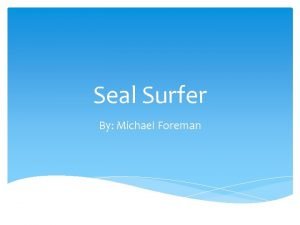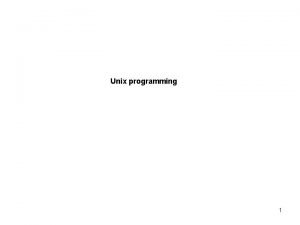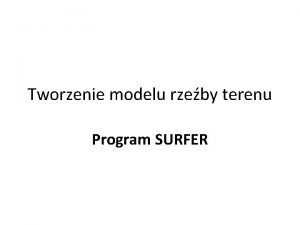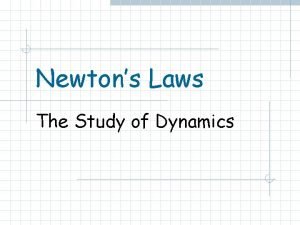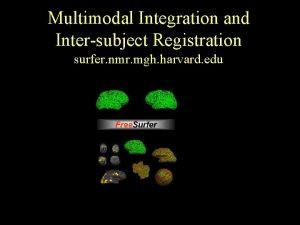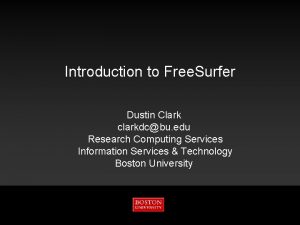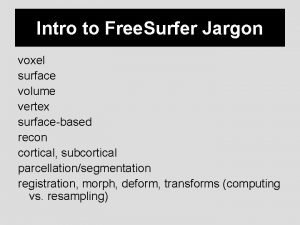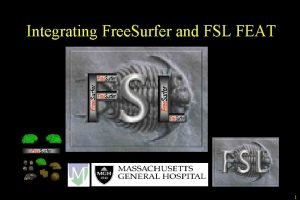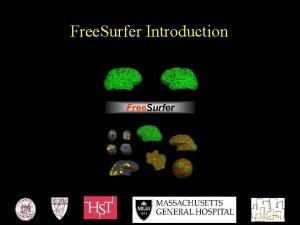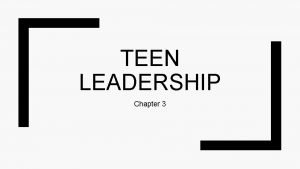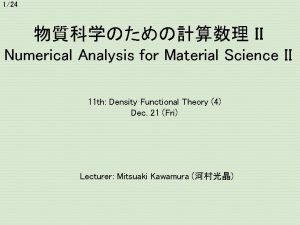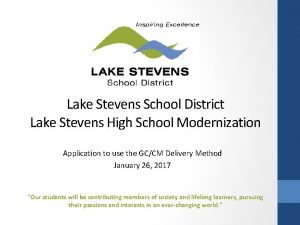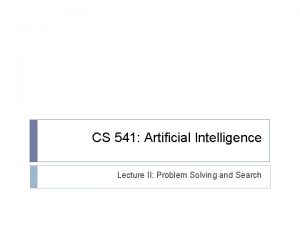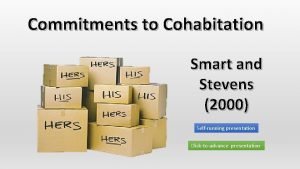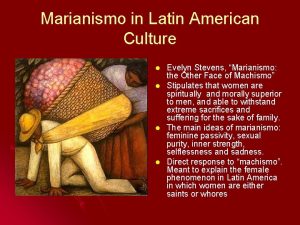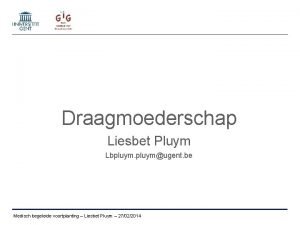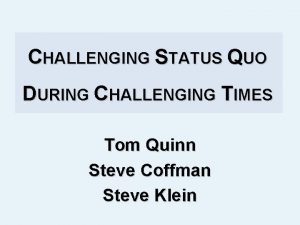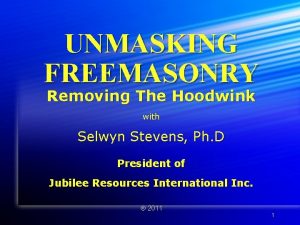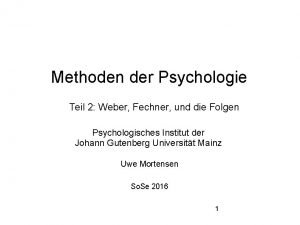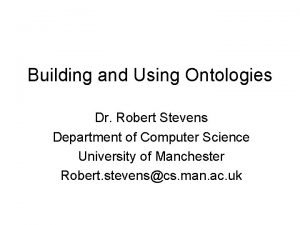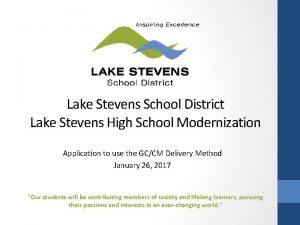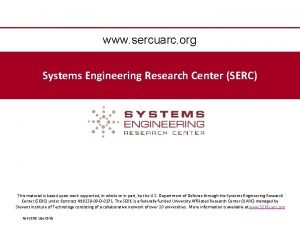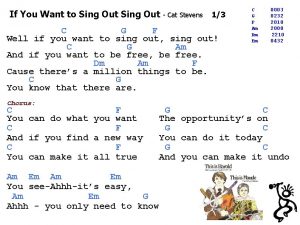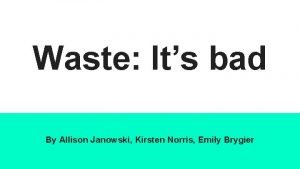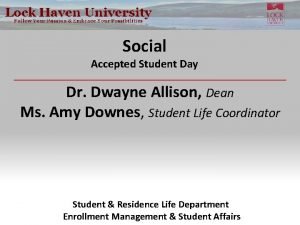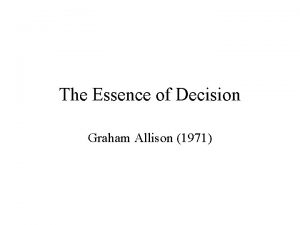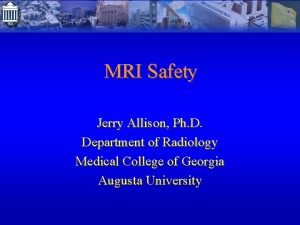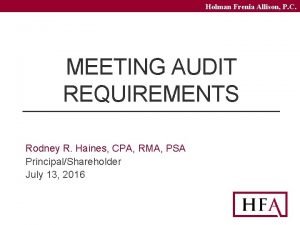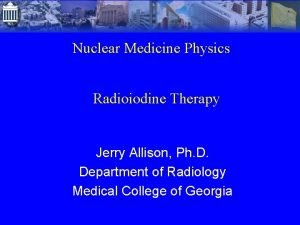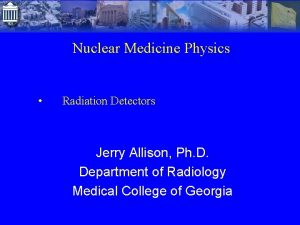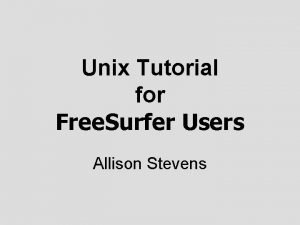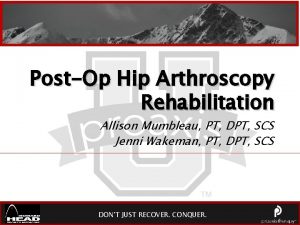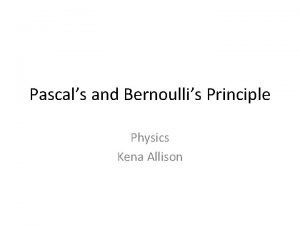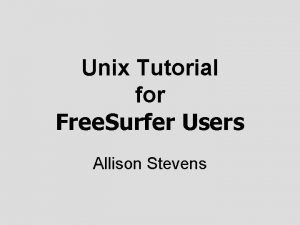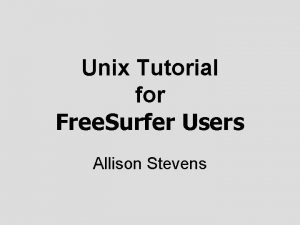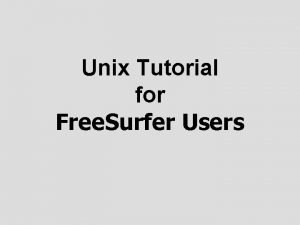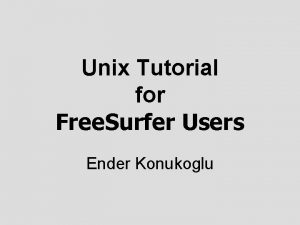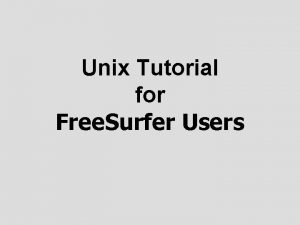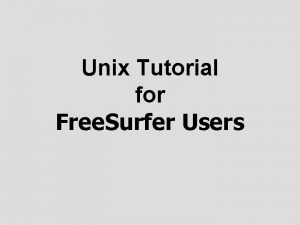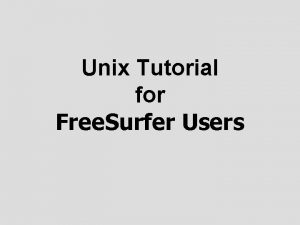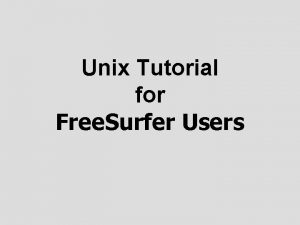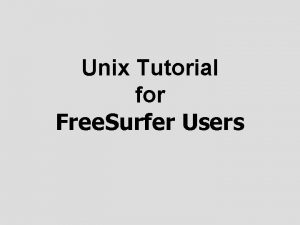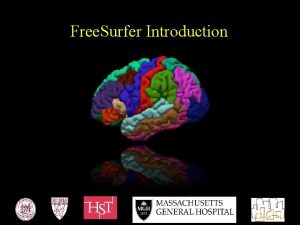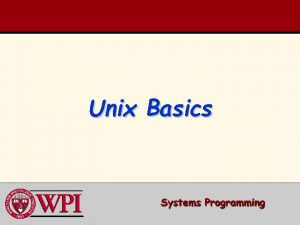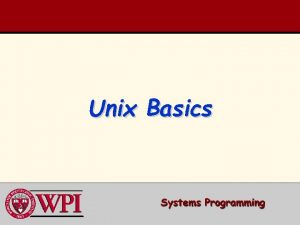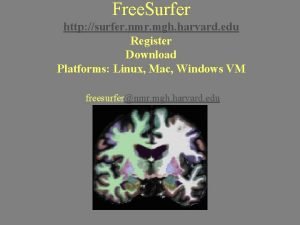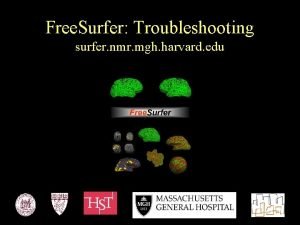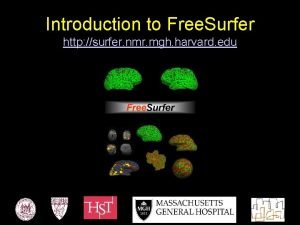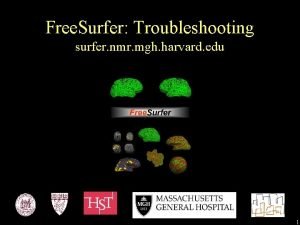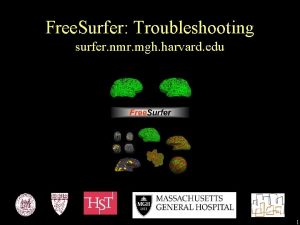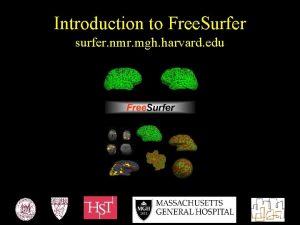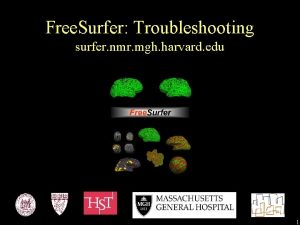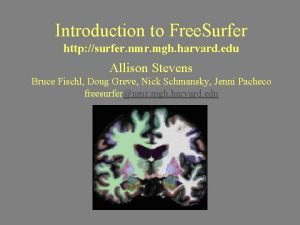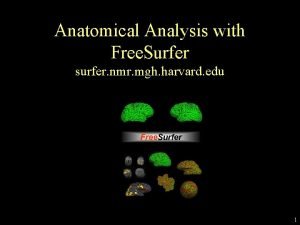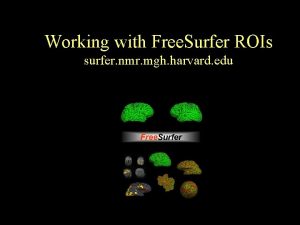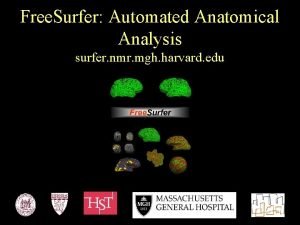Unix Tutorial for Free Surfer Users Allison Stevens













































































- Slides: 77

Unix Tutorial for Free. Surfer Users Allison Stevens

What is Unix/Linux? • An operating system (like Windows and OS X) • Linux is the free, modifiable, and redistributable version of Unix • Why use it?

What is Unix/Linux? • An operating system (like Windows and OS X) • Linux is the free, modifiable, and redistributable version of Unix • Why use it? – power to write many scripts with many commands to work with lots of data – to use computer resources on the network efficiently, such as clusters

Getting Started Communicate with operating system through a “shell” or terminal window. For course-provided Linux computers: Double click Terminal icon on Desktop For Macs: Applications > Utilities > XQuartz (double click) Applications > Utilities > Terminal

Warm Up Type: date and hit enter.

Warm Up Type: date and hit enter. Should see. Mon Apr 2009 6 8: 05: 24 EDT

Warm Up Type: date and hit enter. Should see. Mon Apr 2009 Type: cal and hit enter. 6 8: 05: 24 EDT

Warm Up Type: date and hit enter. Should see. Mon Apr 6 8: 05: 24 EDT 2009 Type: cal and hit enter. Should see April 2009 Su Mo Tu We Th Fr Sa 1 2 3 4 5 6 7 8 9 10 11 12 13 14 15 16 17 18 19 20 21 22 23 24 25 26 27 28 29 30

Directories • Unix uses a hierarchical file system (think folders in Windows)

Directories • Unix uses a hierarchical file system (think folders in Windows) Home is like “My Computer”

Directories • Unix uses a hierarchical file system (think folders in Windows) Home is like “My Computer” Like “My Documents ”

Directories • Unix uses a hierarchical file system (think folders in Windows) Home is like “My Computer” Like “My Documents ” Like “My Photos”

Directories • Unix uses a hierarchical file system (think folders in Windows) Home is like “My Computer” Like “My Documents ” Like “My Photos” picture. jpg

Location path: /My. Computer/My. Documents/My. Photos Type: pwd /home/nmrclass and hit enter. Should see OR /Users/Your. Name shows “present working directory” or current location as a path

Opening a Directory • Not double clicking • Type command to “open” • Commands to open files will differ

Navigating Directories cd __ “change directory”: move into a folder ls ls __ “list”: see contents of directory

Navigating Directories cd __ “change directory”: move into a folder ls ls __ “list”: see contents of directory Desktop matlab tmp TUTORIAL_DATA

Anatomy of a Command command -option 1 –option 2 command - -help file

Anatomy of a Command command -option 1 –option 2 command - -help Try: ls --help file

Directory Contents • List contents of directory you are in ls ls -a ls -lrt lists names of directories/files

Directory Contents • List contents of directory you are in ls ls -a lists names of directories/files lists hidden files too ls -lrt . cshrc. bashrc. alias

Directory Contents • List contents of directory you are in ls ls -a ls -l lists names of directories/files lists hidden files too lists file details ls -lrt drwxrwx--user group others

Directory Contents • List contents of directory you are in ls ls -a ls -lrt lists names of directories/files lists hidden files too lists file details lists recent files last

Save Some Time Filename Completion hit Tab key should see ls Desktop History hit key should see ls Desktop hit enter

Changing Directories mkdir practice makes a new directory “practice” ls -lrt pwd should see cd practice pwd should see ls should see /home/nmrclass changes to directory “practice” /home/nmrclass/practice Nothing!

Changing Directories

Changing Directories mkdir stuff makes folder “stuff” inside practice ls should see “stuff”

Using an Editor emacs mynotes. txt If using a Mac: open -e mynotes. txt Type: I could write a script. File > Save (Buffer) File > Exit emacs ls should see “mynotes. txt” Format > Make plain text File > Save

Using an Editor gedit mynotes. txt If using a Mac: open -e mynotes. txt Type: I could write a script. File > Save (Buffer) File > Exit emacs ls should see “mynotes. txt” Format > Make plain text File > Save

Using an Editor

Copying files cp cp --help is the copy command learn all the options or “arguments” cp mynotes. txt stuff cd stuff ls more mynotes. txt

Copying files cp cp --help is the copy command learn all the options or “arguments” cp mynotes. txt stuff cd stuff ls less mynotes. txt

Changing Directories ls. . /. . shows one directory up goes up two! can also do (but don’t right now): on cd. . /. . pwd should see /home/nmrclass/practice/stuff

Copying / Moving files Could also use do: cp mynotes. txt myothernotes. txt mv hernotes. txt . .

Removing Files pwd ls should be in “stuff” rm mynotes. txt ls

Things to know • Case sensitive • Does not like spaces in file names (e. g. filename. txt vs. file name. txt) • • Ctrl+c kills a process & brings back command prompt Type ‘q’ to quit the program ‘less’ Highlight & middle click to copy & paste Use ‘&’ to open a program in the background Cannot open a 2 nd program if do not have a command prompt

Review • • no double clicking mkdir ls cd pwd emacs, gedit, vi, pico cp rm

Using Free. Surfer With Free. Surfer, certain variables must be set in order to use it correctly: FREESURFER_HOME tell Operating System where Free. Surfer is SUBJECTS_DIR tell Free. Surfer where data is

Required Variables • To use Free. Surfer you’ll have to do: setenv FREESURFER_HOME /home/apps/freesurfer tell Operating System where Free. Surfer is source $FREESURFER_HOME/Set. Up. Free. Surfer. csh source this script to get your computer ready to use Free. Surfer (sources other scripts & sets other variables) setenv SUBJECTS_DIR /path/to/data

Required Variables • To use Free. Surfer you’ll have to do: export FREESURFER_HOME=/home/apps/freesurfer tell Operating System where Free. Surfer is source $FREESURFER_HOME/Set. Up. Free. Surfer. csh source this script to get your computer ready to use Free. Surfer (sources other scripts & sets other variables) export SUBJECTS_DIR=/path/to/data

Required Variables setenv SUBJECTS_DIR /path/to/data To go to location of your data: cd $SUBJECTS_DIR $ means take the value of the variable

Required Variables setenv SUBJECTS_DIR /path/to/data To go to location of your data: cd $SUBJECTS_DIR aka cd /path/to/data $ means take the value of the variable

$ How ‘echo’ works: echo Allison is cool. To set a variable: setenv TEST_VARIABLE yourfirstname To check what a variable is set to: echo $TEST_VARIABLE

Required Variables With Free. Surfer, certain variables must be set in order to use it correctly: FREESURFER_HOME tell Operating System where Free. Surfer is SUBJECTS_DIR echo tell Free. Surfer where data is To check variables $FREESURFER_HOME echo $SUBJECTS_DIR

More Help http: //surfer. nmr. mgh. harvard. edu/fswiki/Fs. T utorial/Command. Line. Navigation Links on Wiki under “Unix Tutorial” Glossary of Unix commands

The End Good Luck!

Intro to Free. Surfer Jargon voxel surface volume vertex surface-based recon cortical, subcortical parcellation/segmentation registration, morph, deform, transforms (computing vs. resampling)

What Free. Surfer Does… Free. Surfer creates computerized models of the brain from MRI data. Input: T 1 -weighted (MPRAGE) 1 mm 3 resolution (. dcm) Output: Segmented & parcellated conformed volume (. mgz)

Intro to Free. Surfer Jargon voxel

Intro to Free. Surfer Jargon surface

Intro to Free. Surfer Jargon surface

Intro to Free. Surfer Jargon vertex

Recon “recon your data” …short for reconstruction …cortical surface reconstruction …shows up in command recon-all

Recon

Volumes orig. mgz T 1. mgz brainmask. mgz wm. mgz filled. mgz (Subcortical Mass)

Cortical vs. Subcortical GM cortical gm subcortical gm sagittal coronal

Cortical vs. Subcortical GM subcortical gm sagittal coronal

Parcellation vs. Segmentation (cortical) parcellation (subcortical) segmentation

Intro to Free. Surfer Jargon voxel surface volume vertex surface-based recon cortical, subcortical parcellation/segmentation registration, morph, deform, transforms (computing vs. resampling)

Free. Surfer Questions Search for terms and answers to all your questions in the Glossary, FAQ, or Free. Surfer Mailing List Archives

Registration Goal: to find a common coordinate system for the input data sets Examples: • comparing different MRI images of the same individual (longitudinal scans, diffusion vs functional scans) • comparing MRI images of different individuals

Inter-subject, uni-modal example target Flirt 612/13/2011 DOF subject Flirt 9 DOF Flirt 12 DOF

Linear registration: 6, 9, 12 DOF target subject Flirt 12 DOF 9 DOF 6

Linear registration: 6, 9, 12 DOF Flirt 6 dof 9 dof target subject Flirt 12 DOF

Linear registration: 6, 9, 12 DOF Flirt 6 DOF 9 target subject Flirt 12 DOF

Intra-subject, multi-modal example before spatial alignment after spatial alignment

before spatial alignment after spatial alignment

before spatial alignment after spatial alignment

Inter-subject non-linear example target CVS reg

Some registration vocabulary • Input datasets: – Fixed / template / target – Moving / subject • Transformation models – rigid – affine – nonlinear • Objective / similarity functions • Applying the results – deform, morph, resample, transform • Interpolation types – (tri)linear – nearest neighbor


Writing Scripts • Putting multiple commands together. • Automatically running a sequence of commands • Example: create a file named my_first_script. csh with the contents: #!/bin/csh setenv name Free. Surfer echo I love $name ! % chmod u+x my_first_script. csh %. /my_first_script. csh

Loops in Scripts • You can create loops, if statements, … • Example: create a file named my_first_loop. csh with the contents: #!/bin/csh foreach name (‘Bill Murray’ ‘Wes Anderson’) echo I love $name ! end

Inputs to Scripts • You can create take inputs from the command line • Example: create a file named my_first_IO. csh with the contents: #!/bin/csh echo The $0 command is called with $#argv parameters echo parameter 1 is $1 echo parameter 2 is $2

Required Variables • To use Free. Surfer you’ll have to do: setenv FREESURFER_HOME /home/apps/freesurfer tell Operating System where Free. Surfer is source $FREESURFER_HOME/Set. Up. Free. Surfer. csh source this script to get your computer ready to use Free. Surfer (sources other scripts & sets other variables) setenv SUBJECTS_DIR /path/to/data

Registration -align subjects -common space -reference points b/w subjects will be same transforms template deform morph warp compute resample

More Help alias e emacs man alias ls file* lists file 1, file 2, file 3 ls file[12] lists file 1 and file 2 but not file 3 command >>& file. txt save output to screen and errors in text file
 Stevens unix
Stevens unix Stevens unix network programming
Stevens unix network programming Free surfer
Free surfer Seal surfer by michael foreman
Seal surfer by michael foreman Unix tutorial ppt
Unix tutorial ppt Surfer kriging
Surfer kriging Newton's 3 law
Newton's 3 law Surfer
Surfer Surfer
Surfer Surfer
Surfer Free
Free Tksurfer
Tksurfer Surfer
Surfer Surfer
Surfer Random surfer model
Random surfer model Surfer's myelopathy
Surfer's myelopathy Interpersonal skills in soul surfer
Interpersonal skills in soul surfer Fermi surfer
Fermi surfer Fermi surfer
Fermi surfer Usc innovation
Usc innovation Peace train cat stevens lyrics meaning
Peace train cat stevens lyrics meaning Lake stevens school district
Lake stevens school district Cs 541
Cs 541 Smart and stevens cohabitation
Smart and stevens cohabitation Bryn stevens
Bryn stevens Smart and stevens cohabitation
Smart and stevens cohabitation Evelyn stevens marianismo
Evelyn stevens marianismo Liesbet pluym
Liesbet pluym Inge holsbeeks
Inge holsbeeks Stevens institute of technology
Stevens institute of technology Unmasking freemasonry
Unmasking freemasonry Dave stevens palo alto networks
Dave stevens palo alto networks Bison ranch sustainability
Bison ranch sustainability Reel to reel institute
Reel to reel institute Legge di stevens
Legge di stevens Implizit
Implizit Robert stevens manchester
Robert stevens manchester Stevens johnson syndrome
Stevens johnson syndrome Sami yusuf nationality
Sami yusuf nationality Olivia stevens death
Olivia stevens death Marybeth murphy stevens institute
Marybeth murphy stevens institute Wally stevens
Wally stevens Fromme423
Fromme423 Dr lauren stevens
Dr lauren stevens Stevens school
Stevens school Stevens power law
Stevens power law Serc stevens
Serc stevens New frontiers beliefs
New frontiers beliefs Cat stevens hallelujah
Cat stevens hallelujah Allison janowski
Allison janowski Allison tayler
Allison tayler Takedown allison van diepen
Takedown allison van diepen Now allison dean
Now allison dean Avatrombopag
Avatrombopag Professor robert allison
Professor robert allison Allison fansler
Allison fansler Allison lorenz
Allison lorenz Allison lackie
Allison lackie King of all media
King of all media Graham allison models
Graham allison models Allison rislov
Allison rislov Dr lee allison
Dr lee allison Jerry allison
Jerry allison Allison rossett
Allison rossett Htc grid mammography
Htc grid mammography Holman frenia allison, p.c.
Holman frenia allison, p.c. Allison corbat
Allison corbat Allison beth quillin
Allison beth quillin Jerry allison
Jerry allison Jerry allison
Jerry allison Scenario examples
Scenario examples Allison
Allison Allison bloodworth
Allison bloodworth Allison morgan ts
Allison morgan ts Allison maclaurin
Allison maclaurin Allison mumbleau
Allison mumbleau Allison
Allison Greatest lower bound and least upper bound
Greatest lower bound and least upper bound



